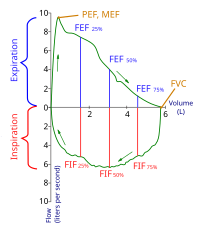
Photo from wikipedia
Background Alveoli tend to collapse in patients with acute respiratory distress syndrome (ARDS). Endotracheal aspiration may increase alveolar collapse due to loss of end-expiratory lung volume (EELV). We aim to… Click to show full abstract
Background Alveoli tend to collapse in patients with acute respiratory distress syndrome (ARDS). Endotracheal aspiration may increase alveolar collapse due to loss of end-expiratory lung volume (EELV). We aim to compare loss of EELV after open and closed suction in patients with ARDS. Methods This randomized cross-over study was conducted with twenty patients who were followed up under invasive mechanical ventilation due to ARDS. Open suction and closed suction were applied in random order. Lung impedance was measured with electric impedance tomography. Changes in end-expiratory lung impedance (EELI) were represented as the change in EELV during suction, at 1, 10, 20, and 30 minutes after suction. Arterial blood gas analysis and ventilatory parameters such as plateau pressure (Pplat), driving pressure (Pdrive), and compliance of the respiratory system (CRS) were also recorded. Results Closed suction caused less volume loss after suction when compared with open suction (mean ΔEELI -2661±1937 vs. -4415±2363 mean difference -1753; 95% CI, -2662 to -844, P=0.001). EELI reached to baseline after 10 minutes of closed suction, it could not reach to baseline even after 30 minutes of open suction. Ventilatory parameters such as Pplat, Pdrive, decreased and CRS increased after closed suction, on the contrary, Pplat, Pdrive, increased and CRS decreased in open suction. Conclusions Endotracheal aspiration may lead to alveolar collapse due to EELV loss. Instead of open suction, closed suction should be chosen in patients with ARDS since it causes less volume loss at end-expiration and does not worsen ventilatory parameters.
Journal Title: Korean journal of anesthesiology
Year Published: 2023
Link to full text (if available)
Share on Social Media: Sign Up to like & get
recommendations!